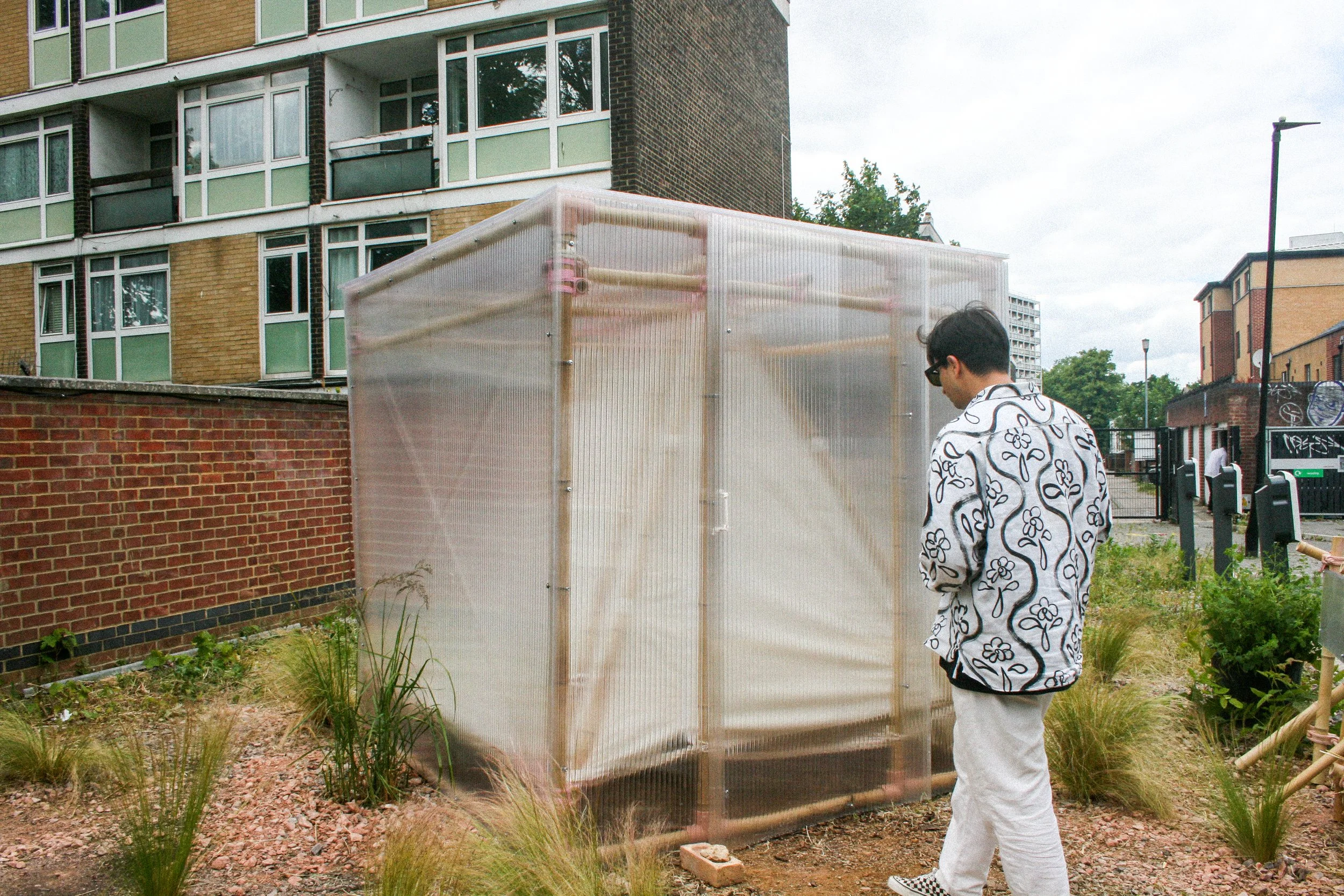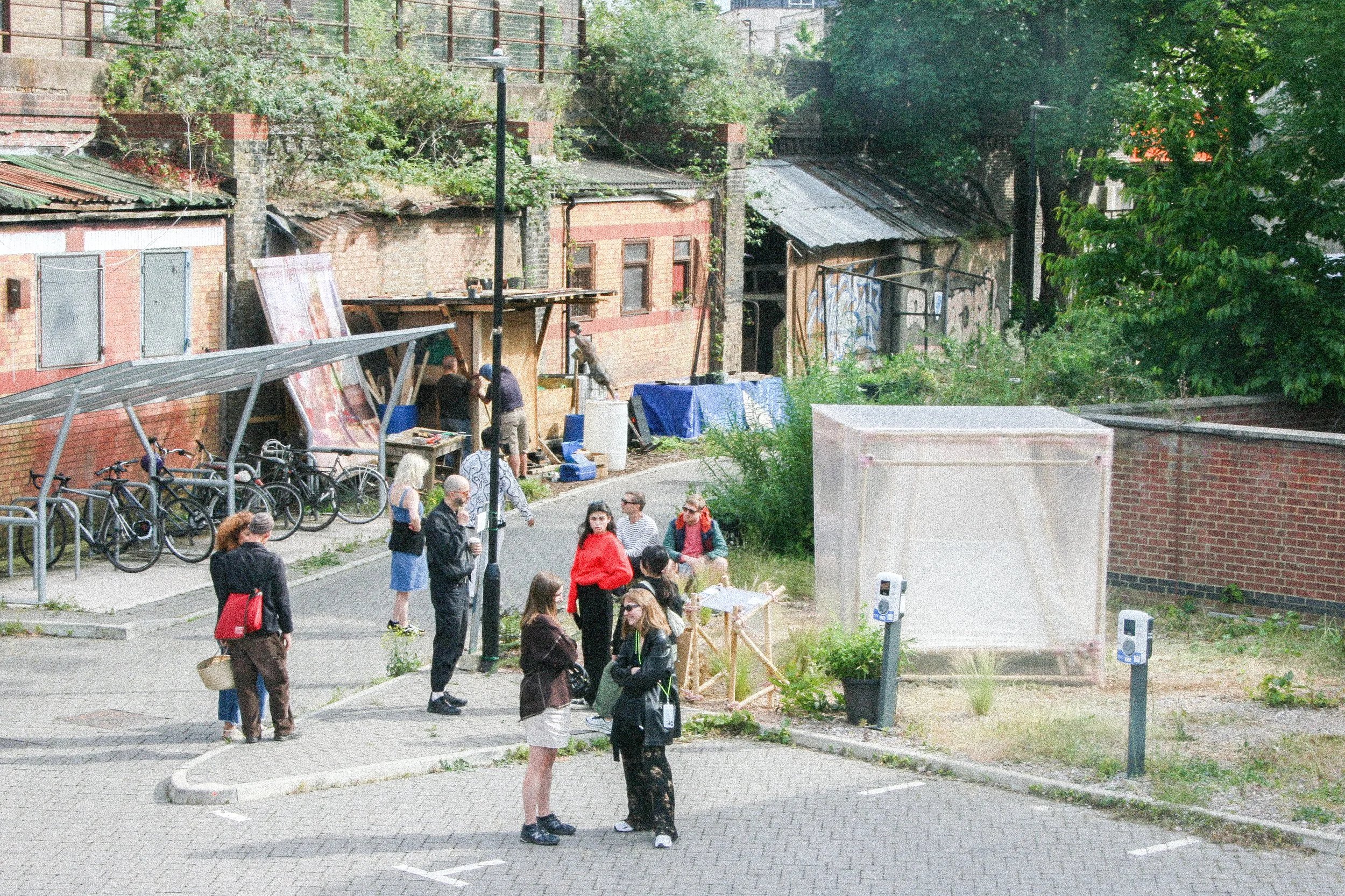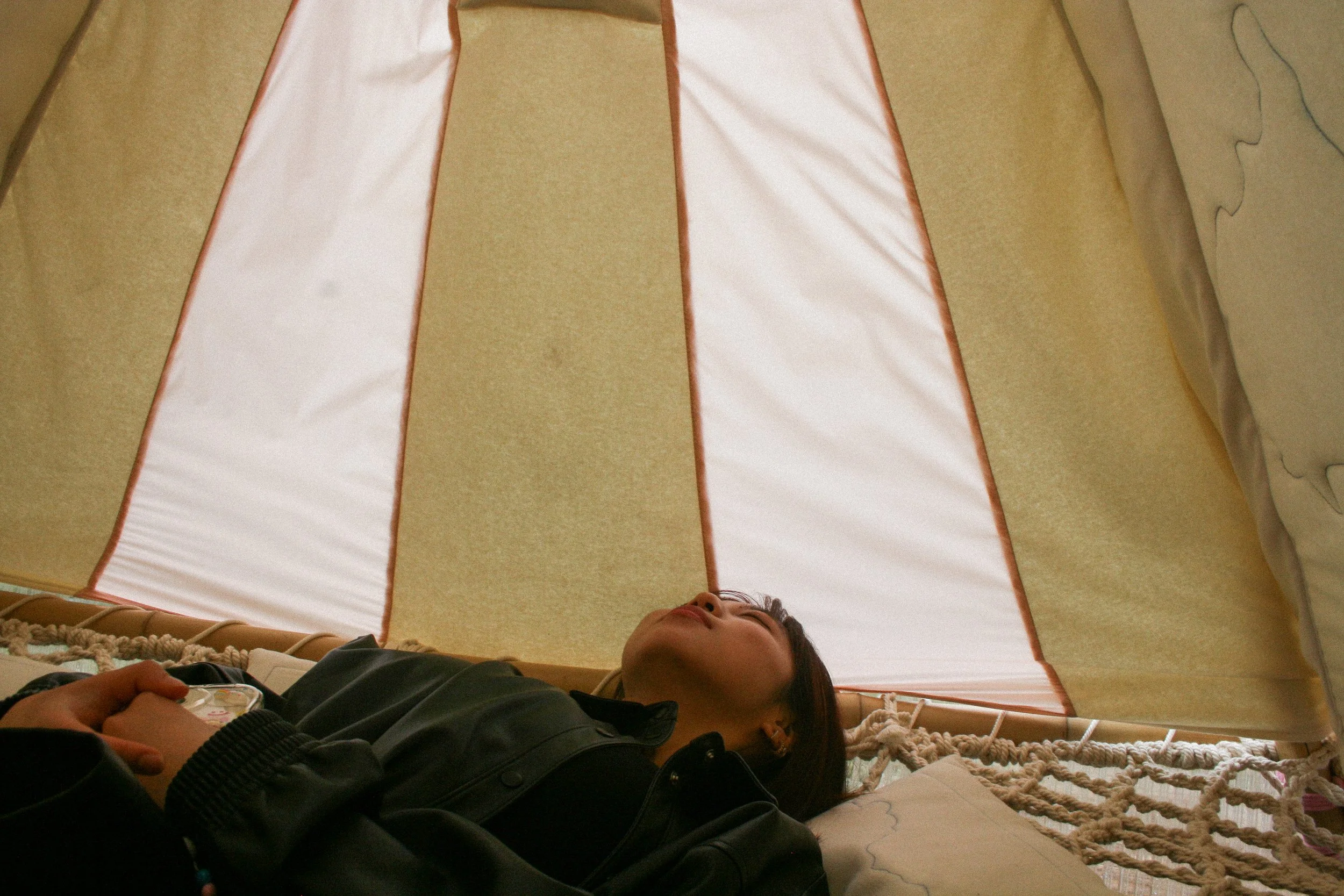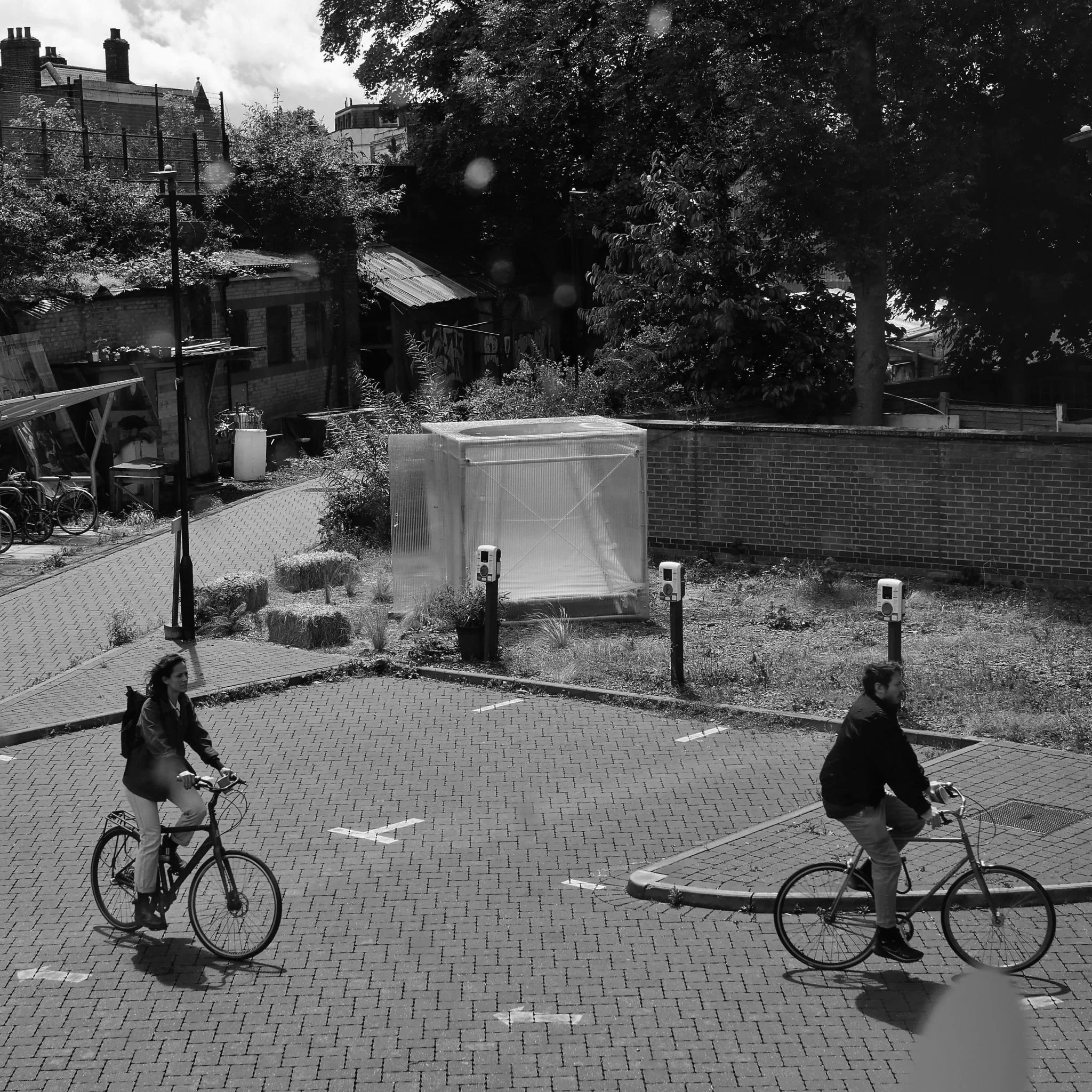SILENT ROOM V.04 by Nathalie Harb
In collaboration with Gerard Gormley
Commissioned by SONCITIES and presented as part of the London Festival of Architecture, Silent Room V.04 is a sonic architecture by Nathalie Harb, part of a series of urban typologies that reimagine the city through listening. Its tent-like structure evokes a refuge, claiming the city as a place of belonging and rest. Responding to the Loughborough Junction railway station site, it is a meditation on migration and movement. A soundtrack by Gerard Gormley transplants other sounds into the site, acting as a sonic crossroads. Silent Room V.04 is a call to attune to the city of the future as a dwelling-place centred around human well-being.
Illustrations of Silent Room V.04 by Alexandros Tzortzis de Paz & Nathalie Harb
Notes on design
Nathalie Harb’s Silent Room has manifested in various forms since 2017, when Silent Room V.01, a two-storey, temporary architecture, was installed in a parking lot at the intersection of a highway, an industrial site, and a low-income neighborhood in Beirut. Proposed as an acoustic refuge that anyone could access, Silent Room V.01 used acoustic paneling to reduce environmental noise, but it also featured a meditative soundtrack by Khaled Yassine composed of city sounds at its quietest hours between 3 AM and 5 AM. It asked: why has quiet become a luxury that only few can access? Silent Room V.01 was a meditation on noise as a social injustice: the uneven ways in which noise affects rich and poor inhabitants of the city. Harb observed, “Our cities are often configured in such a way that underprivileged communities are the most affected by higher noise pollution”.
Harb imagined that Silent Room could one day become a public utility, and that acoustic refuges or places of sonic well-being should not be seen as a luxury but rather as “a necessity, something that’s needed in urban planning.” The current iteration of Silent Room at LJ Works is designed with this in mind. It is a portable structure made of affordable and sustainable materials such as bamboo and fabric. Its design evokes the most basic form of shelter, the tent, into whose fabric the borders between various nations have been carefully sewn. Yet, in an age marked by displacement and continuous migration, even the tent as a form of shelter is under question, as seen in the recent attacks by Israel on displaced Palestinians sheltering in tents in Rafah, Gaza. Silent Room V.04 invites us to consider what refuge means in such a time; and what constitutes shelter in different contexts. As a space of quietness, reduced information influx, and focused listening, it is an invitation to acknowledge and bring to mind the losses of our day.
Silent Room V.01 by Nathalie Harb, in collaboration with BUF architecture, Khaled Yassine, and 21 dB. Photo by Nadim Asfar.
Notes on sound
For the sound component of Silent Room V.04, sound artist GerardGormley interweaves over forty field recordings he made in Ireland, Lebanon, Armenia, Mexico and Barbados, as well as open source recordings from Haiti and Cabo Verde shared on the platform Radio Aporee. He brought these sounds to Loughborough Junction Farms, playing them into materials at the site using vibrational speakers, which cause materials to vibrate, and recording the resulting vibrations using contact microphones. He says, “You’re not only hearing the original sounds; you’re also hearing them as they were sounded through the materials of the site: wood, steel, brick, metal, and plastic.” Gormley also recorded sounds in the local area, including of trains and transport; and of people speaking in different languages, thinking of voices as sonic markers of intersecting cultures. “The idea with filtering the sounds through the site is that, when all these different cultures come together in one place, when people migrate, they’re not bringing unfiltered cultures; the culture they bring to a new place is filtered through the place itself and the other cultures they’re exposed to.” The composition enacts a similar process in sound.
Biography for Nathalie Harb
Nathalie Harb is a multidisciplinary artist and designer based between Paris and Beirut. She creates public interventions, installations, and set designs that question the notions of home, shelter and agency by proposing an alternative use of our daily habitat. Forming Nathalie Harb Studio in 2017, she envisions it as a collaborative space where diverse practitioners, musicians, acoustic consultants, permaculture experts, environmental advisors, and architects, among others, converge to shape projects spanning urban interventions, community workshops, and exhibitions. The studio’s projects have been supported by such organisations and initiatives as UNESCO’s Week of Sound, the American University Beirut’s Neighborhood Initiative, the London Design Biennale, the British Council, and the European Research Council.
Biography for Gerard Gormley
Gerard Gormley is an Irish sound artist whose work explores the actual and latent sonic potentials of spaces, buildings, and sites. His work evolves through various experimental processes that explore sound in relation to space and architecture. This might be an iterative process of recording sounds and vibrations at a site and playing them back into that site, such that the site becomes a carrier of sound and music that was created from it; or transplanting sounds from one place to another, bringing various places and their sonic and material histories into dialogue. His work is granular and hyper-detailed, taking place at the level of microsonic and micro-textural investigation. It has been shown at daadgalerie, After (Berlin), The MAC Belfast, Modern Art Oxford, Cannes Festival, Storung Festival (Spain), The Cube at Virginia Tech, and broadcast nationally on cinema and television in Ireland and the UK.










Photos of Silent Room V.04 launch and installation views at LJ Works. Photos by Gaia Vignali, Carla @cujolina, and Nathalie Harb.
SILENT ROOM V.04 IN THE NEWS
STIRWORLD. ‘Nathalie Harb on creating a ‘Silent Room’ within the city as a space of refuge’. By Mrinmayee Bhoot. 18 July, 2024
FRAME. ‘Are We Ignoring the Acoustic Potential of Public Space’? By Nishi Shah. 19 August, 2025.
CREDITS
Concept and design: Nathalie Harb
Sound: Gerard Gormley
Curator: Gascia Ouzounian
Architect: Alexandros Tzortzis de Paz
Contractor: Bler Gjana/Gjana Contractors
Green Space arrangement: Gavin Smith
Hosted by: Meanwhile Space at LJ Works
Caretakers: Hani Ali, Eden Bhutia, Charlie Brook, Aarohi Dalvi, Caitlin Morgan, Vivian Provasi Takara, Gaia Vignali
Acknowledgements: 21dB, John Bingham-Hall, Freya Bishop, Adriana Cobo Corey, Tom Dobson, Diana Ibáñez López, LJ Works, Polly Nuttgens
Commissioned by: SONCITIES



